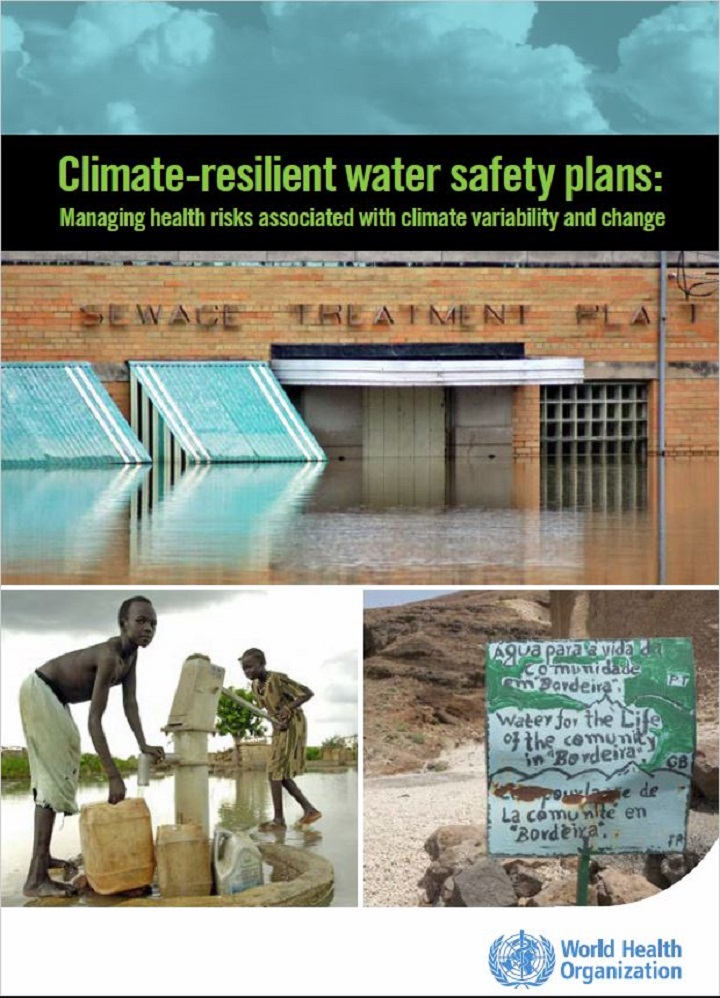Climate-resilient water safety plans Managing health risks associated with climate variability and change WHO (2017)
Medium- and long-term planning for an adequate and safe supply of drinking-water should be set in the context of growing external uncertainties arising from changes in the climate and environment. The water safety plan (WSP) process offers a systematic framework to manage these risks by considering the implications of climate variability and change.
This document provides guidance on how climate considerations can be integrated into water safety planning to provide greater resilience to the current and predicted impacts of climate change and variability on water supplies. The guidance is supported by numerous practical examples of climate resilient water safety planning from both lower and higher income settings.
The guidance is intended to help water suppliers and WSP teams who have already committed to using the WSP approach and are developing and implementing WSPs to gain greater understanding of climate change and how it can be considered and addressed in the WSP process. This document will also be useful to other stakeholders, particularly health and environment agencies who are supporting WSP implementation.
Long-term planning for an adequate and safe supply of drinking-water should be set in
the context of growing external uncertainties arising from changes in the climate and
environment. The water safety plan (WSP) process offers a systematic framework to manage
these risks by considering the implications of climate variability and change.
This document is intended to help water suppliers and WSP teams who have already
committed to using the WSP approach and are developing and implementing WSPs to gain
greater understanding of climate change and how it can be considered and addressed in the
WSP process. This document will also be useful to other stakeholders, particularly health
and environment agencies who are supporting WSP implementation. It discusses how to
take into consideration the broader issues of climate change, regional climate vulnerability
assessments, disaster risk reduction and integrated water resources management within the
WSP process. The details of how this is done for any particular WSP depend upon local
circumstances.
The document identifies opportunities to enhance the WSP process and outcomes by
considering the provision of safe water in sufficient quantity under changed future
conditions and extreme weather events that may become more frequent and severe as the
climate changes.
This guidance is aligned with the WSP modules as described in the World Health
Organization/International Water Association Water safety plan manual. Therefore, this
document is intended to be used in conjunction with the Water safety plan manual to
ensure that climate change is considered as part of the WSP comprehensive risk assessment,
management and continual improvement process.
The document presents the current state of knowledge on the impacts of climate change
on the water cycle, drawing on information in the scientific literature, particularly the
Intergovernmental Panel on Climate Change Fifth Assessment Report.
The document describes those modules of the Water safety plan manual where climate
variability and change should be explicitly considered to ensure effective management of
these risks through the WSP process. These modules are 1 (“Assemble the WSP team”),
2 (“Describe the water supply system”), 3–5 (“Identify hazards and hazardous events and
assess the risks”, “Determine and validate control measures, reassess and prioritize the
risks”, and “Develop, implement and maintain an improvement/upgrade plan”), 8 (“Prepare
management procedures”) and 9 (“Develop supporting programmes”). Key activities to be
undertaken to support inclusion of climate change-related risks are described below.
The WSP team should consider past climate-related events that negatively affected the water
supply system and learn about climate projections that could impact hazards and risks for
the water supply system in the future. As described in modules 1 and 2 (sections 5.1 and 5.2
of this document), WSP teams may need to draw on expertise and information from other
parties, such as specialists in hydrology and climatology, to understand potential climate
change impacts in the context of their water supply.
When identifying hazards, assessing risks and planning improvements, as described in
modules 3–5 (sections 5.3 and 5.4 of this document), WSP teams need to take a broad view
of the potential risks. Changes in the climate feed into changes in environmental and social
systems, which can impact the nature of the hazards and exposures ordinarily considered
and introduce new hazards. Both the likelihood and severity of the consequences arising
from the hazard or hazardous event are likely to change due to climate variability and change.
Modules 8 and 9 (section 5.6 of this document) of the Water safety plan manual cover the
development of management procedures and supporting programmes. At a broad level these
modules include developing programmes to build the institutional and individual capacity
of water suppliers to manage risks associated with water scarcity and reliability in addition
to water quality risks. These programmes include management procedures, for example
emergency response plans (such as flood or drought management plans). The programmes
can be used to bring together stakeholders from different disciplines to support a more
catchment-based and holistic approach to managing water resources, for more resilient
water supplies.
When considering climate change, and seeking to adapt to the change and improve resilience
to increased climatic variability, the WSP team may identify opportunities and practices to
work in partnership with others and influence their plans and programmes where these
relate to the scope and implementation of the WSP.
Additional sources of information, detailed case studies and examples are provided
throughout the document and as annexes at the end.
Bibliographic information
WHO (2017). Climate-resilient water safety plans Managing health risks associated with climate variability and change World Health Organization, Geneva, Switzerland
Filter / Tags
Guidelines and manualsEnglishSFD General Library

